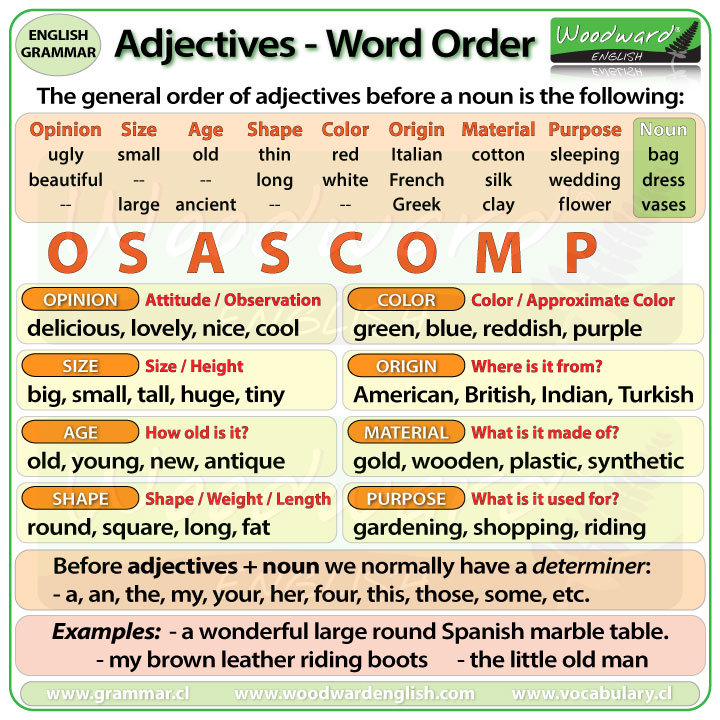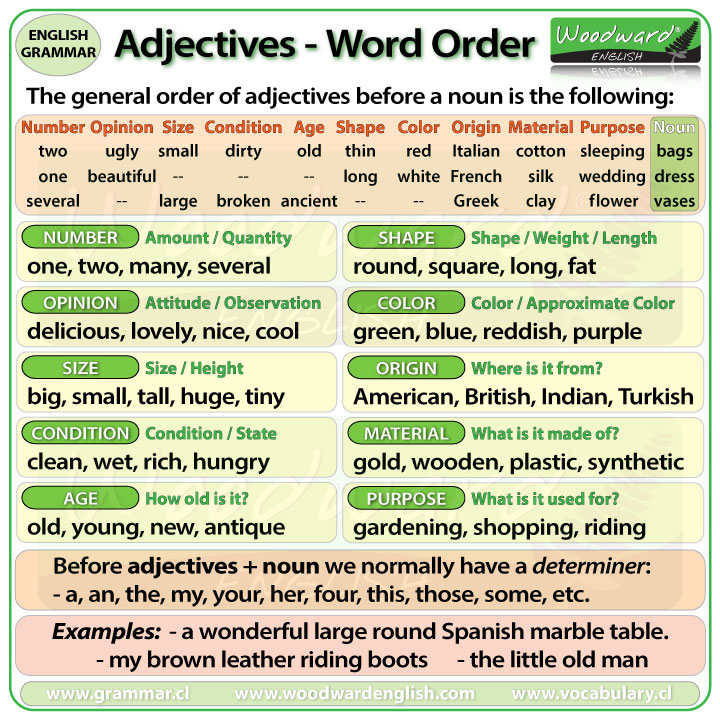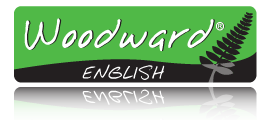What is an adjective?
An adjective is a word that describes something (a noun).
An adjective gives us more information about a person or thing.
Correct order of adjectives
Adjectives sometimes appear after the verb To Be (CARD – LINK TO VIDEO)
The order is To Be + Adjective.
- He is tall.
- She is happy.
Adjectives sometimes appear before a noun.
The order is Adjective + Noun.
- Slow car
- Brown hat
BUT… Sometimes you want to use more than one adjective to describe something (or someone).
What happens if a hat is both brown AND old?
Do we say… an old brown hat OR a brown old hat?
An old brown hat is correct because a certain order for adjectives is expected.
A brown old hat sounds incorrect or not natural.
So what is the correct order of adjectives before a noun?
The order of adjectives before a noun is usually the following:
Opinion – Size – Age – Shape – Color – Origin – Material – Purpose
If we take the first letter of each one, it creates OSASCOMP which is an easy way to remember the order.
Let’s look at an example about describing a bag.
- It is an ugly small old thin red Italian cotton sleeping bag
It is not common to have so many adjectives before a noun, but I do this so you can see the correct order of adjectives.
Ugly is an opinion, small is a size, old refers to age, thin refers to shape, red is a color, Italian refers to its origin, cotton refers to the material the bag is made of, sleeping is the purpose of the bag.
I will go into more details about each of these categories in a moment. First, let’s see two more examples:
- A beautiful long white French silk wedding dress.
- Large ancient Greek clay flower vases.
Let’s study the first one.
Here we have a dress. Dress is a noun, the name of a thing. Let’s describe this dress.
What type of dress is it? What is the purpose of this dress?
It is used for weddings so it is…
- a wedding dress.
Let’s image the dress is made of silk. It isn’t made of plastic or gold, it is made of silk.
Silk is a material so it goes before the purpose. We say it is:
- a silk wedding dress.
Now, this dress was made in France. France is a noun, its adjective is French.
Its origin is French. Its origin, French, goes before the material, Silk. So we say it is:
- a French silk wedding dress.
Let’s add the color of the dress. What color is it? White. Color goes before Origin so we say it is:
- a white French silk wedding dress.
What is the shape of this dress? Is it long or short? It is long. The adjective Long goes under the category of shape because shape also covers weight or length. (We will see more about this in a moment) We now say it is:
- a long white French silk wedding dress.
Let’s add one more adjective. Is the dress beautiful or ugly? Well, you should always say it is beautiful or it will ruin her wedding day.
Beautiful is an opinion and adjectives about opinions go before all the other adjectives. So our final description of the dress is:
- a beautiful long white French silk wedding dress.
Now of course we don’t normally add so many adjectives before a noun. This example is just to show you the order of adjectives.
The order is NOT fixed
IMPORTANT: The order of adjectives before a noun is NOT 100% FIXED.
This chart is only a guide and is the order that is preferred.
You may see or hear slight variations of the order of adjectives in real life though what appears in the chart is the order that is expected the most.
Now, let’s look at each type of adjective in more detail (with examples)…
Types of Adjectives
OPINION
Opinion: These adjectives explain what we think about something. This is our opinion, attitude or observations that we make. Some people may not agree with you because their opinion may be different. These adjectives almost always come before all other adjectives.
Some examples of adjectives referring to opinion are:
- delicious, lovely, nice, cool, pretty, comfortable, difficult
For example: She is sitting in a comfortable green armchair.
Comfortable is my opinion or observation, the armchair looks comfortable. The armchair is also green.
Here we have two adjectives. The order is comfortable green armchair because Opinion (comfortable) is before Color (green).
SIZE
Size: Adjectives about size tell us how big or small something is.
Some examples of adjectives referring to size are:
- big, small, tall, huge, tiny, large, enormous
For example: a big fat red monster.
Notice how big is first because it refers to size and fat is next because it refers to shape or weight. Then finally we have the color red before the noun.
AGE
Age: Adjectives of age tell us how old someone or something is. How old is it?
Some examples of adjectives referring to age are:
- old, young, new, antique, ancient
For example: a scary old house
Scary is my opinion, old refers to the age of the house. Scary is before old because opinion is before age.
SHAPE
Shape: Also weight and length. These adjectives tell us about the shape of something or how long or short it is. It can also refer to the weight of someone or something.
Some examples of adjectives referring to shape are:
- round, square, long, fat, heavy, oval, skinny, straight
For example: a small round table.
What is the shape of the table? It is round.
What is the size of the table? It is small.
The order is small round table because size is before shape.
COLOR
Color: The color or approximate color of something.
Some examples of adjectives referring to color are:
- green, blue, reddish, purple, pink, orange, red, black, white
(adding ISH at the end makes the color an approximate color, in this case reddish is “approximately red”)
Our example: a long yellow dress.
What is the color of the dress? It is yellow.
The dress is also long. Long which is an adjective of shape or more precisely length, is before an adjective of color.
ORIGIN
Origin: Tells us where something is from or was created.
Some examples of adjectives referring to origin are:
- American, British, Indian, Turkish, Chilean, Australian, Brazilian
Remember, nationalities and places of origin start with a capital letter.
For example: an ancient Egyptian boy.
His origin is Egyptian. Egyptian needs to be with a capital E which is the big E.
Ancient refers to age so it goes before the adjective of origin.
MATERIAL
Material: What is the thing made of or what is it constructed of?
Some examples of adjectives referring to material are:
- gold, wooden, plastic, synthetic, silk, paper, cotton, silver
For example: a beautiful pearl necklace
Pearl is a material. They generally come from oysters.
The necklace is made of what material? It is made of pearls.
The necklace is also beautiful so I put this adjective of opinion before the adjective referring to material.
PURPOSE
Purpose: What is it used for? What is the purpose or use of this thing? Many of these adjectives end in
–ING but not always.
Some examples of adjectives referring to purpose are:
- gardening (as in gardening gloves), shopping (as in shopping bag), riding (as in riding boots)
Our example: a messy computer desk
What is the purpose of the desk? It is a place for my computer, it is designed specifically to use with a computer. It is a computer desk. In this case, the desk is also very messy. Messy is an opinion. Some people think my desk is messy. So, the order is opinion before purpose.

So this is the general order of adjectives in English and you can remember them by the mnemonic OSASCOMP.
BUT did you know that we could add some extra categories?
BONUS ADJECTIVE GROUPS
We can add the adjective categories of Number and Condition.
NUMBER
Number: Tells us the amount or quantity of something.
It is not only for normal cardinal numbers like, one, two, three… but also other words that refer to quantity such as many or several.
Our examples of adjectives referring to numbers are:
- One, two, three, many, several
For example: three hungry dogs
Number adjectives go before all the other adjectives, including adjectives about opinion.
Hungry is a condition or state so the order is Three hungry dogs.
CONDITION
Condition: Tells us the general condition or state of something
Our examples of adjectives referring to condition or state are:
- Clean, wet, rich, hungry, broken, cold, hot, dirty
For example: Two smelly old shoes.
Smelly is a condition or state. Smelly is before old which refers to age. The number two is at the beginning as numbers always are.
Adjectives – Word Order – Summary Chart

